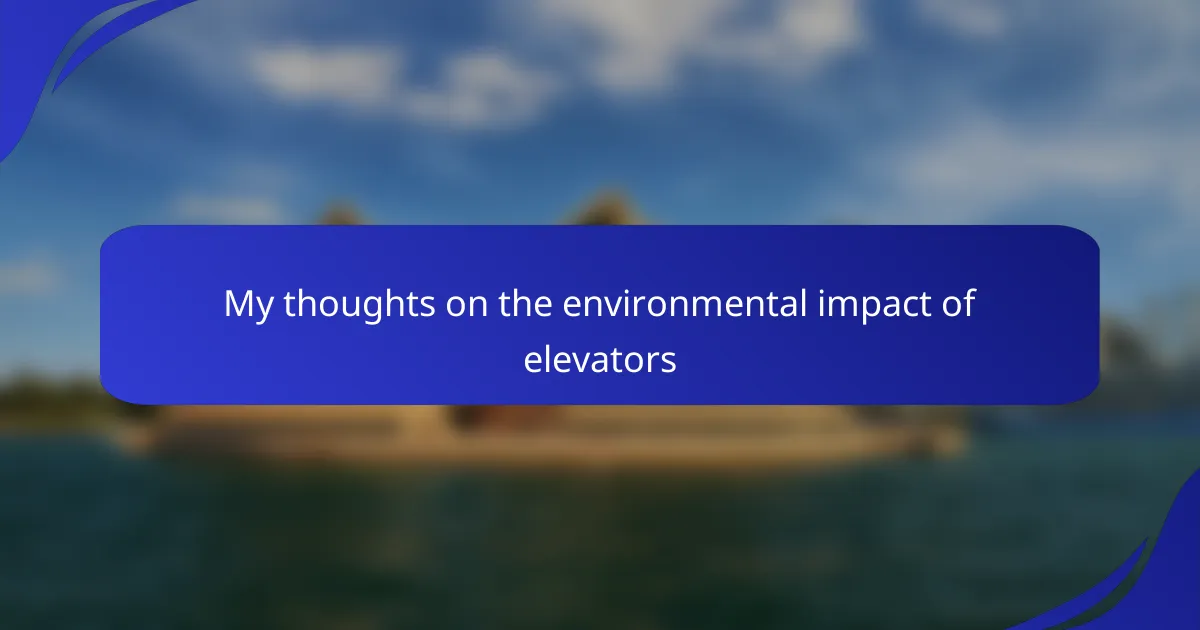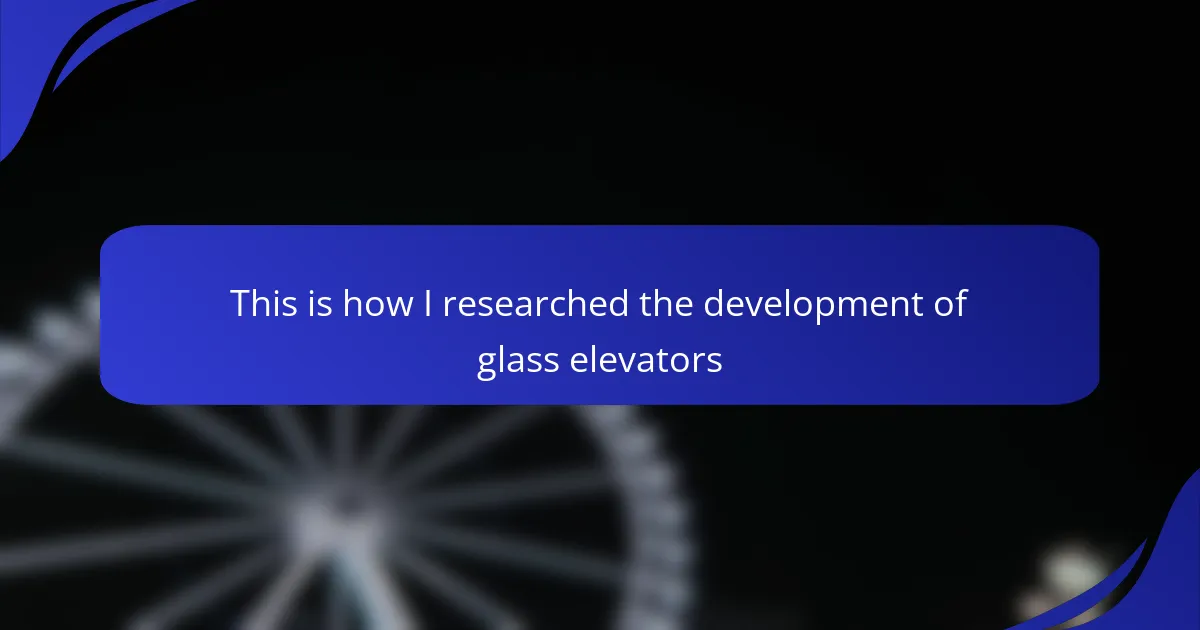Key takeaways
- Elevators have evolved from simple hoisting devices to energy-efficient systems integral to urban architecture, enhancing accessibility and sustainability.
- Innovations such as regenerative drives and smart technologies are significantly reducing energy consumption and improving safety in modern elevators.
- The focus on sustainable practices in the elevator industry includes using eco-friendly materials and integrating renewable energy sources to lower the carbon footprint.
- Regular maintenance and the adoption of smart technologies can maximize efficiency and usability, contributing positively to the environment.

Definition of elevators
Elevators are mechanical systems designed to transport people and goods between different floors of a building. They typically consist of a platform or car that moves vertically along a shaft, powered by electric motors or hydraulic systems. In my experience, using elevators not only enhances accessibility but also transforms how we interact with urban spaces.
When I think about elevators, I recognize their evolution over time. Once limited to grand hotels or skyscrapers, they are now commonplace in residential buildings, shopping malls, and various commercial structures. It’s fascinating to see how they’ve become integral to our daily lives, breaking down the barriers of height and making multi-story spaces more navigable.
- They come in various types: hydraulic, traction, and machine-room-less elevators.
- Elevators improve accessibility for individuals with mobility challenges.
- They can enhance building efficiency and safety by easing the transport of goods and people.
- Energy-efficient models are becoming more common, reflecting a growing awareness of their environmental impact.

Overview of elevator industry
The elevator industry has undergone remarkable changes since its inception. Initially, these systems were seen as luxury features, but today, they have become essential components in the architectural landscape of our cities. I often ponder how these unseen machines quietly transform our experiences, making previously inaccessible spaces available to everyone.
Throughout my research, I’ve come to appreciate the different types of elevators in use. Whether it’s the robust hydraulic systems that power older buildings or the sleek, space-saving machine-room-less designs that modern structures embrace, each type serves a specific need. Don’t you find it amazing how engineering adapts to meet evolving demands?
What stands out to me is the growing emphasis on energy-efficient models. As our awareness of environmental impact increases, so does the responsibility of industries like elevators to innovate. I’ve seen first-hand how integrating green technologies can not only minimize energy consumption but also contribute to a building’s overall sustainability, positively affecting both our environment and the user experience.
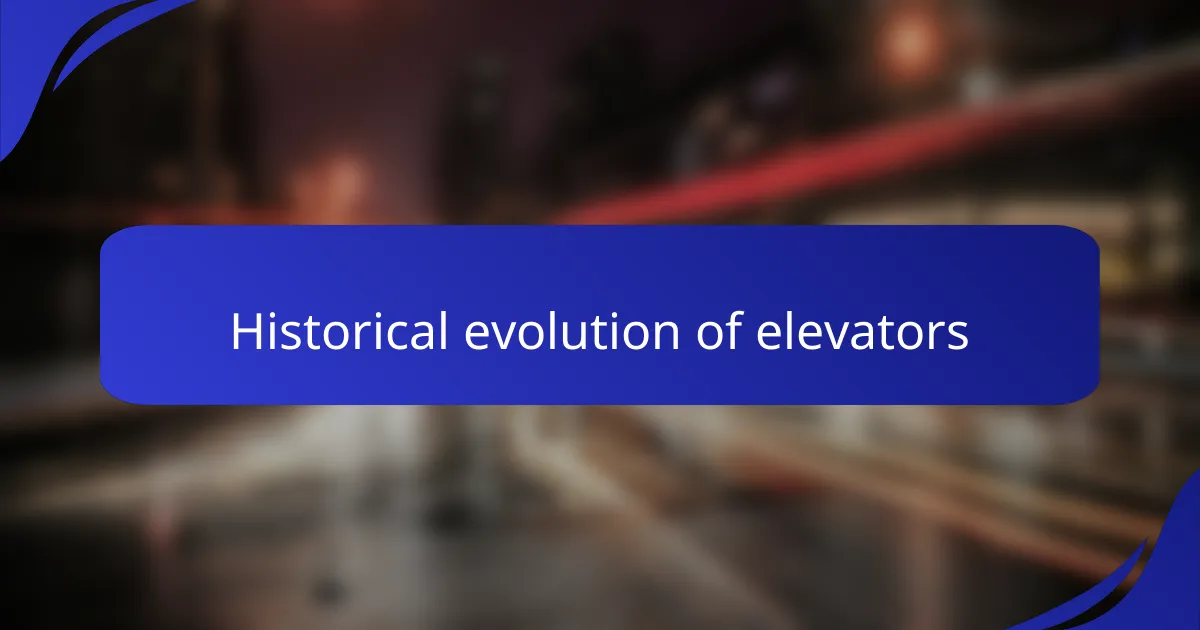
Historical evolution of elevators
It’s fascinating to see how elevators have evolved over time. Initially, they were simple hoisting devices powered by human or animal labor. As I delve into the history, I feel a deep appreciation for the innovations that have shaped our urban landscapes.
The introduction of steam-powered elevators in the 19th century was a game changer. I remember visiting a historic building in my city where a vintage steam elevator still operates, and it made me reflect on how far we’ve come. Today, we have highly efficient electric elevators, some equipped with regenerative drives that can actually feed energy back into the grid.
This progression reflects not just technological advancement, but also a growing consciousness about sustainability. It makes me hopeful that future innovations in the elevator industry will prioritize environmental impact, continuing this journey while minimizing ecological footprints.
| Era | Key Features |
|---|---|
| Ancient Times | Human/Animal-Powered Systems |
| 19th Century | Steam-Powered Elevators |
| 20th Century | Electric Elevators with Safety Systems |
| 21st Century | Energy-Efficient Models with Regenerative Drives |
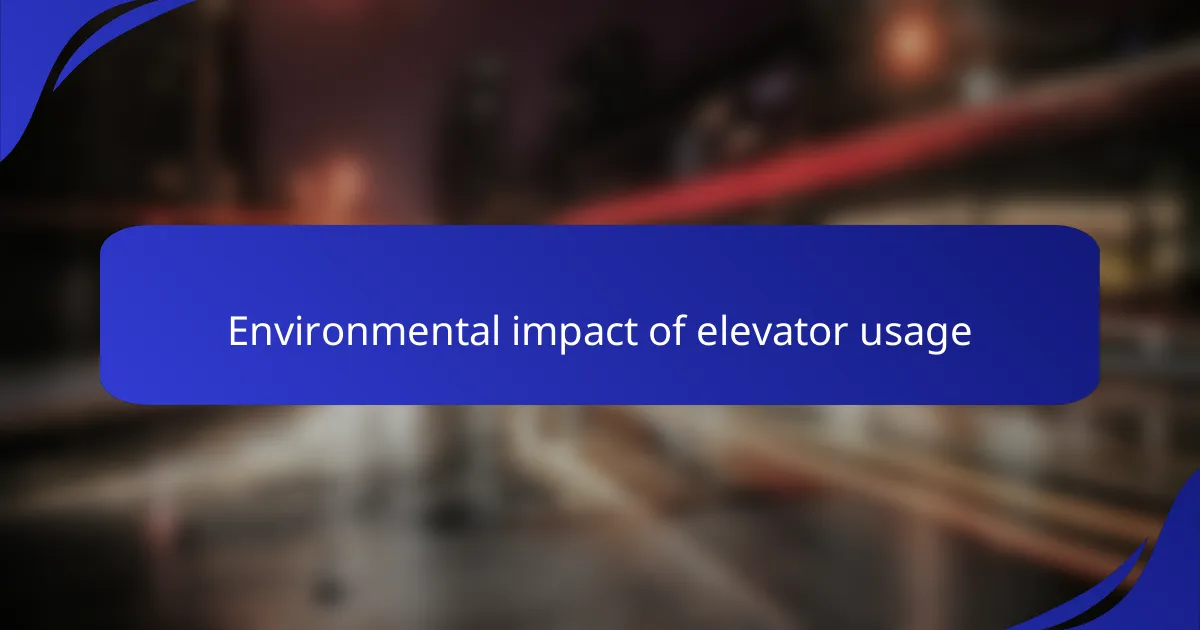
Environmental impact of elevator usage
It’s intriguing to think about the environmental impact of elevators. When I consider how often we rely on these machines in our daily lives, I realize their energy consumption is significant. Modern elevators, especially those equipped with energy-efficient technologies, can actually reduce the overall carbon footprint of buildings.
I remember visiting a high-rise that had recently upgraded to regenerative drives, which not only enhanced energy savings but also reduced noise pollution. This kind of innovation showcases the potential of elevators to contribute to greener buildings. However, it’s essential to acknowledge that while elevators provide convenience, their environmental impact depends heavily on the energy sources powering them.
To illustrate the differences in environmental impact, I’ve included a comparison table showing traditional versus energy-efficient elevators:
| Elevator Type | Environmental Impact |
|---|---|
| Traditional Elevators | Higher energy consumption, more carbon emissions |
| Energy-Efficient Elevators | Lower energy use, potential for regenerative energy capture |

Innovations in elevator technology
Innovations in elevator technology are continually reshaping how we experience urban environments. One of the most significant advancements has been the introduction of machine-room-less (MRL) elevators. They are sleek and save valuable space in buildings. I remember stepping into one for the first time and being amazed at how efficient it was, almost like stepping into the future.
Another critical development is the use of smart technology in elevators. This means they can communicate with building management systems to optimize energy use based on real-time demand. Wouldn’t it be great if every elevator could learn from our habits? Imagine riding in one that knows to go directly to your floor during peak hours, reducing wait times and energy consumption at the same time. This not only enhances user experience but aligns with a broader push for smarter, greener cities.
Looking at advanced safety features, I find it remarkable how modern systems are equipped with sensors that can detect issues before they become problems. I once experienced a power outage while in an elevator, but the comfort of knowing it had a backup system truly put my mind at ease. These innovations don’t just enhance efficiency—they significantly improve safety and reliability, showing that the elevator industry is committed to looking out for both its users and the planet.
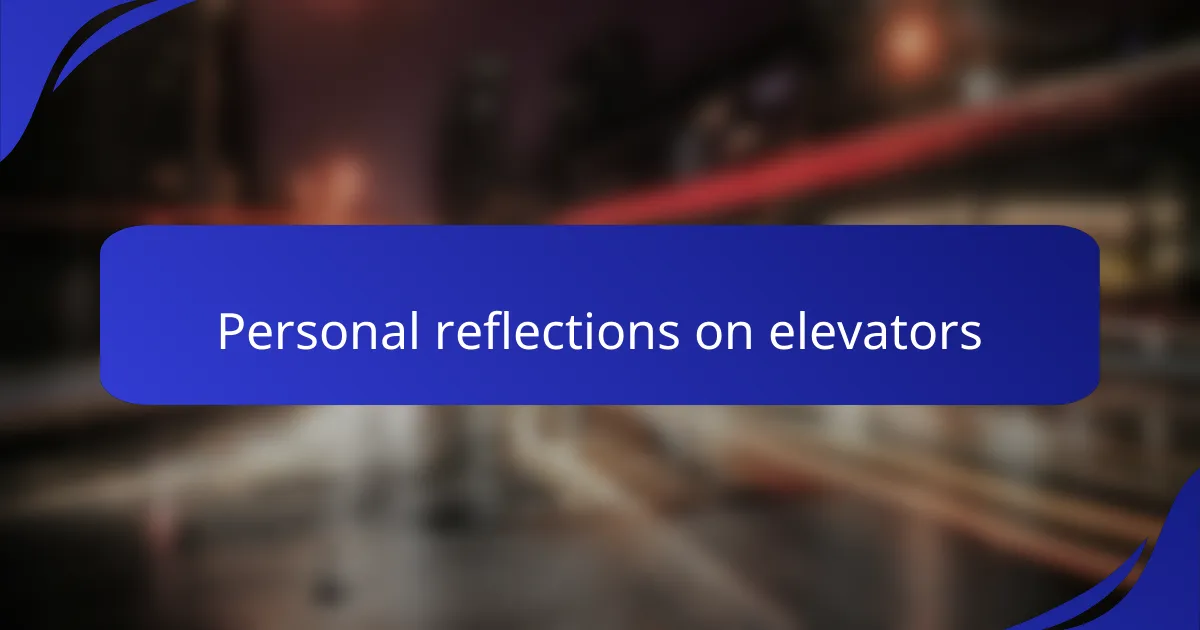
Personal reflections on elevators
When I think about elevators, I often recall a visit to a towering skyscraper in a bustling city. The sleek, high-speed elevator whisked me smoothly up dozens of floors, offering a breathtaking view of the city below. It struck me then how these machines not only enhance our convenience but also play a role in shaping urban environments and their energy consumption.
Reflecting on my experience, I recognize that elevators can pose significant environmental challenges. However, they can also be part of the solution with advancements in energy-efficient technologies. I’ve been impressed by innovations like regenerative drives and smart control systems that maximize energy savings. These developments showcase how the elevator industry is evolving to reduce its ecological footprint.
- Energy-efficient elevator systems can reduce power consumption by up to 50%.
- Regenerative drives capture energy during descent and can re-use it during ascent.
- Smart technologies prioritize operational efficiency, ensuring elevators only run when necessary.
- Eco-friendly materials in construction can lower the carbon footprint of new installations.
- Regular maintenance can enhance performance and longevity, directly impacting resource use.
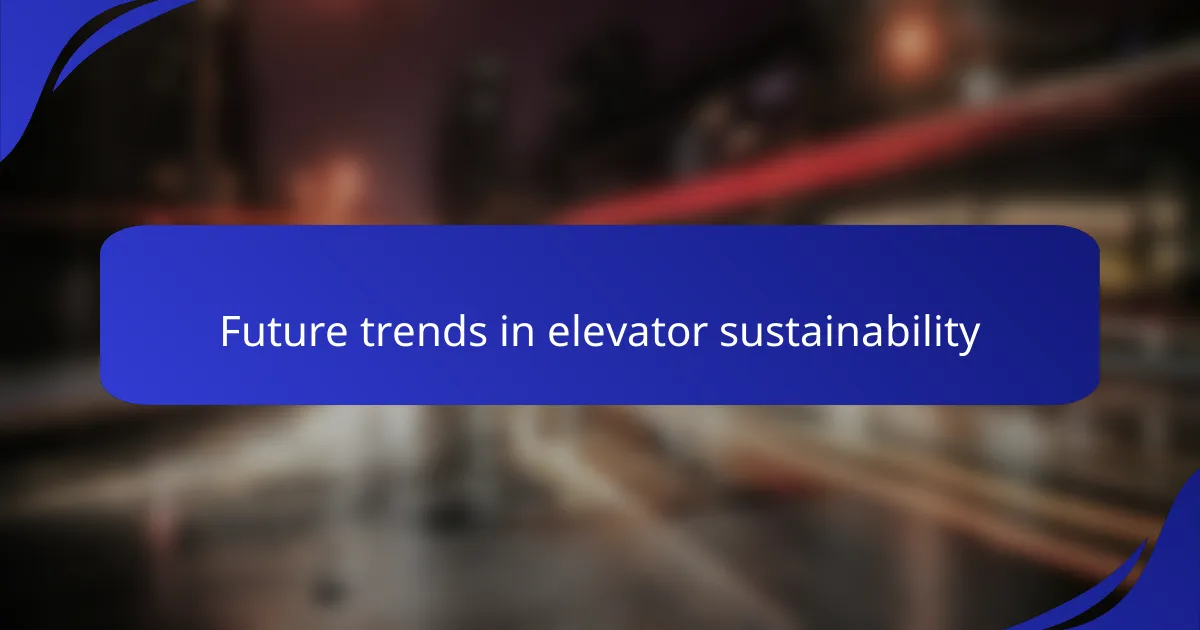
Future trends in elevator sustainability
As I reflect on the future trends in elevator sustainability, I find it exciting how the industry is shifting towards greener practices. The use of regenerative drives, which capture and reuse energy, is a significant step forward. It’s incredible to think about how small changes in technology can lead to substantial energy savings in the long run.
Moreover, innovations in materials are likely to play a pivotal role. I remember a recent conversation with a friend who works in the green architecture sector; we discussed how elevators could be constructed with recycled or eco-friendly materials, reducing their overall carbon footprint. Sustainable design isn’t just a trend; it’s becoming a necessity.
Here are some promising trends in elevator sustainability:
- Regenerative Drives: These systems capture excess energy during operation and convert it into usable power.
- Geothermal and Solar Power Integration: Some modern elevators are now being powered by renewable energy sources like solar panels or geothermal systems.
- Lightweight Materials: Advances in materials science are enabling the use of lightweight, recycled materials, minimizing the overall energy consumption of elevators.
- Smart Technology: IoT (Internet of Things) features can optimize energy use and maintenance schedules, reducing unnecessary energy expenditure.
- Eco-Friendly Lubricants: Switching to biodegradable and eco-friendly lubricants lowers the environmental impact of elevator maintenance.
